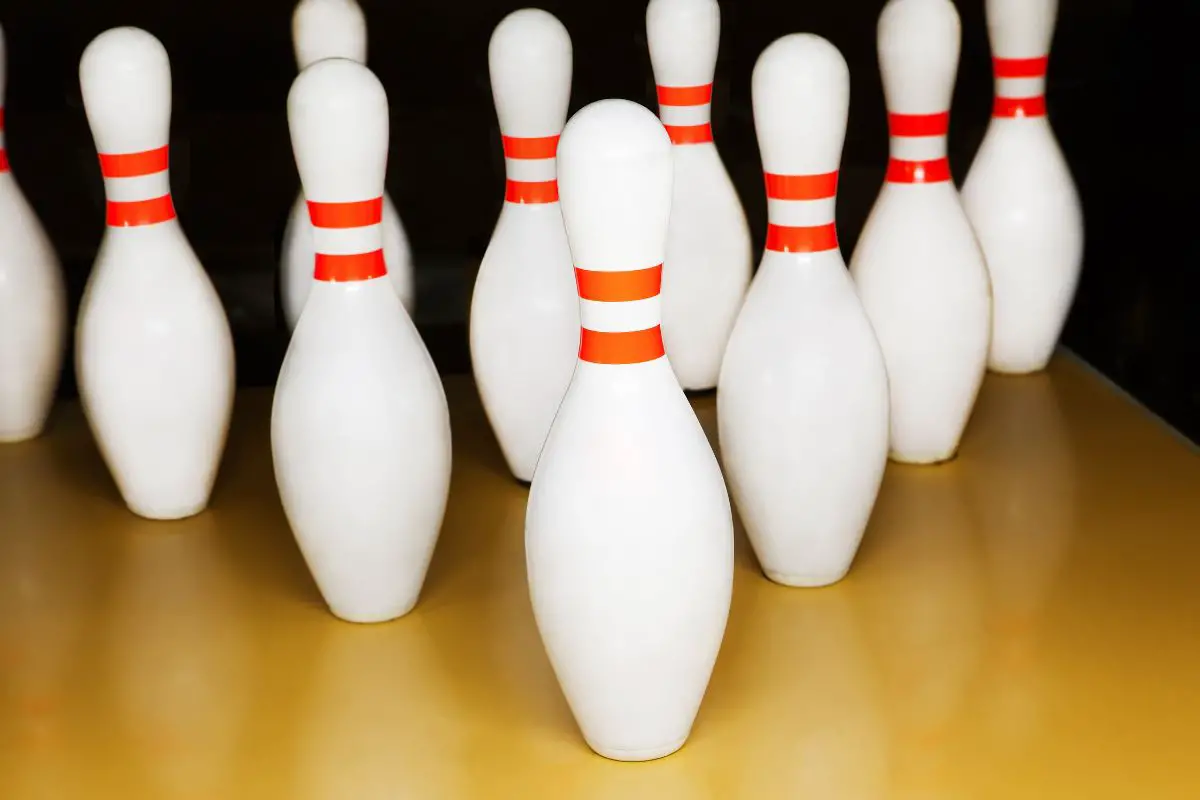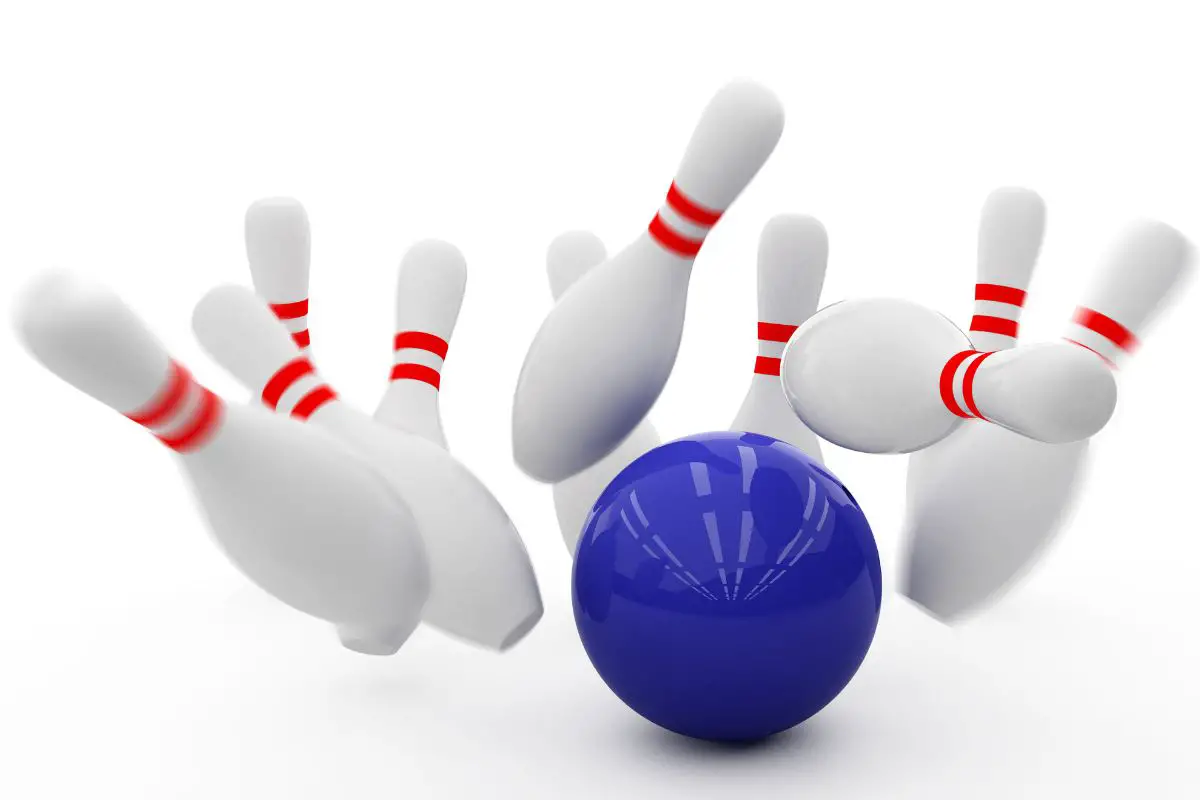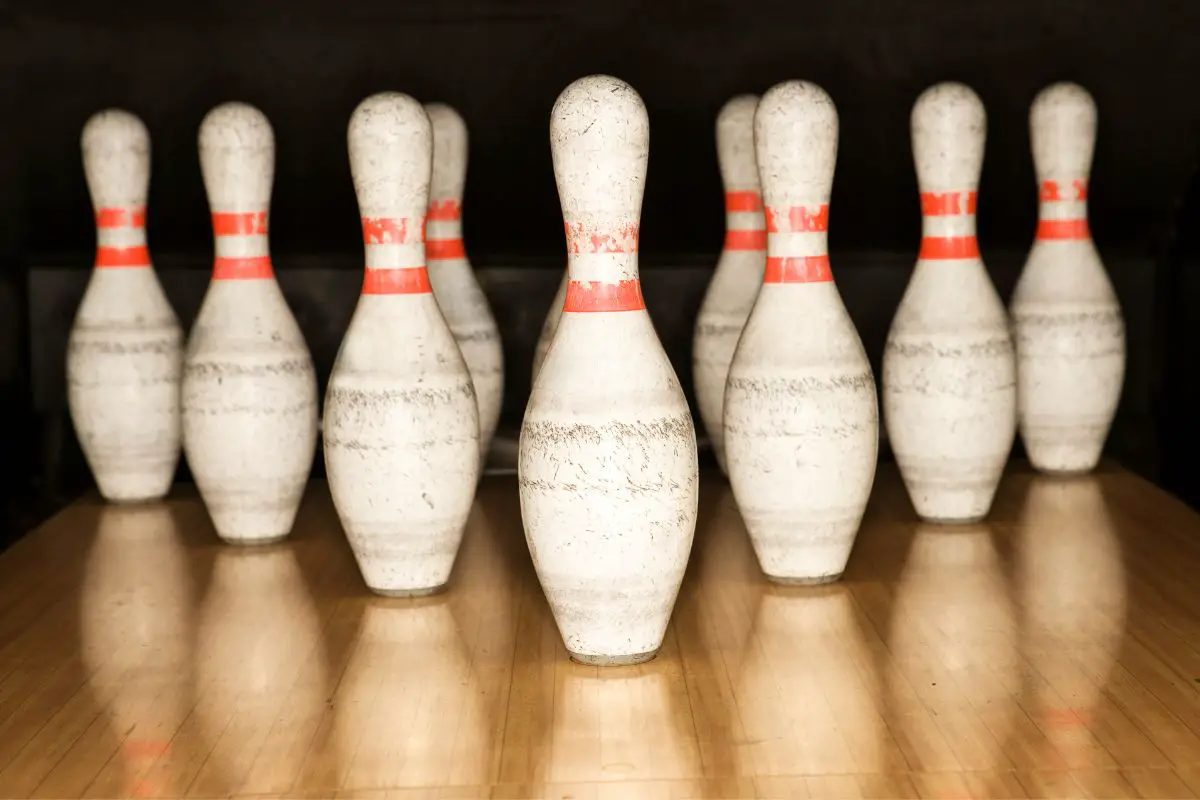Contrary to popular belief, several varieties of bowling go beyond the classic ten-pin bowling game.
As a result of these varieties, each game has its number of pins that need to be knocked down.

So, whether you’re a keen bowling enthusiast or merely curious about the game, you’re probably wondering, “How many pins are there in bowling”?
Here is everything you need to know about how many pins there are in bowling, including the most common games and some rarer bowling varieties.
How Many Pins Are There In Bowling?
Ten-pin Bowling
In the most common game of bowling, ten-pin bowling, there are – you guessed it – ten pins!
These pins are arranged in the shape of a triangle, with the tip pointing towards the player.
The player then has to try and throw the bowling ball in the direction of the pins, with the aim of knocking as many pins over as possible.
Ten is the most common number of pins because the pins make the most even triangle shape, making for the fairest shot.
Ten-pin bowling is now most commonly referred to as “bowling” and is considered the most conventional and popular form of bowling, as recognized by the United States Bowling Congress, American Bowling Congress, British Ten-pin Bowling Association, and Women’s International Bowling Congress.
Ten-pin bowling is also the most competitive bowling variety there is and is generally considered the only form of bowling by those who don’t know about the other variations. In professional settings, such as competitions and leagues, the only competitive game is ten-pin bowling.
The game of ten-pin bowling is simple – aim to knock down as many of the ten pins as possible within the ten frames.
Each frame allows two shots, except for the tenth and final frame, where you get extra shots for a strike.
Scoring is simple: you earn one point for every pin you knock down (e.g., knocking down 7 pins earns you 7 points).
Now, strikes and spares bring bonuses. A strike is when you clear all 10 pins in one shot, earning you an immediate 10 points. Plus, your next two shots have their scores doubled.
For instance, if you knock down 4 and 8 pins with those shots, you get 22 points.
On the other hand, a spare happens when you clear all 10 pins in two shots in one frame. You score 10 points plus the bonus from your first shot in the next frame.
For example, if you take down 6 pins with that next shot, you’ll have 16 points.

Nine-pin Bowling
As the name suggests, nine-pin bowling is a variation of the classic ten-pin bowling game, except with just nine pins!
Interestingly enough, nine-pin bowling is quite different from ten-pin bowling.
Nine-pin bowling is a primarily European game that is team-only, rather than ten-pin bowling, which is played individually.
This game is also called “Kegel,” its original name when it originated in Germany.
Also, rather than laying out the pins in the classic ten-pin triangle style, nine-pin bowling pins are set up in the shape of a diamond, making the overall formation wider than a ten-pin triangle.
This is believed to make nine-pin bowling harder than ten-pin bowling because there is more distance between the pins, making it harder to knock them all down simultaneously.
Other than the formation and number of pins (as well as the gameplay of playing in a team vs individually), those are the key differences between nine-pin and ten-pin bowling.
The bowling ball for nine-pin bowling remains the same, with three holes for the thumb, middle, and ring fingers.
However, unlike ten-pin bowling alleys, where a machine automatically sets up the pins, nine-pin bowling pins typically need to be set up manually.
This is because nine-pin bowling is less common than ten-pin bowling unless you’re in Europe, where there might be nine-pin bowling alleys.
This is why many nine-pin bowling setups have strings or wires connected to the pins.
This is designed to knock over the pins without the pins flying everywhere, so you don’t have to climb between the lanes to pick up random pins. Still, there will be a designated pin-setter for this game.
Nine-pin bowling is slightly different in terms of frames and scoring. There are six frames instead of ten, and the aim is still to knock down all the pins in one shot.
All the pins are white except for a red pin in the middle. Players receive a point for every pin they knock down, so if they knock down all 9, they receive 9 points.
However, here’s the catch. If they knock down all white pins and not the red one, they will receive 12 points for their team.
This is easier said than done, making nine-pin bowling a challenging variation.

Five-pin Bowling
As the name suggests, five-pin bowling is another variation of ten-pin bowling, except with only five pins!
This is a Canadian version of the game with five pins in a V-shape formation.
These pins are smaller than the nine-pins and ten-pins and are knocked down with a smaller ball without holes.
Interestingly, the rules of five-pin bowling are slightly different from ten-pin and nine-pin bowling.
Rather than every pin amounting to one point, each pin in five-pin bowling has its own point number.
The two pins on the outside are worth two points each, the pins in the middle are worth three points, and the pin in the center is worth five points.
Players are then given three shots in one frame to knock down as many pins as possible to get the highest score.
There are ten frames overall, and instead of the highest score being 300, the maximum is 450. Five-pin bowling is undoubtedly more of a strategic than a skillful game.
Five-pins also look very different from nine-pins or ten-pins. The pins are significantly shorter and feature a weighted rubber band in the middle, which helps to make it harder to knock the pins over.
Candlepin And Duckpin Bowling
Two other variations of bowling are candlepin and duckpin bowling, which are arguably the most uncommon kinds of bowling.
Candlepin bowling is very similar to regular ten-pin bowling, consisting of ten pins with a similar point system.
However, as the name suggests, these pins are tall and cylindrical to mimic candlesticks.
This makes it harder to knock down all of the pins, which is emphasized by the smaller bowling ball.
Duckpin bowling also features ten duckpins, shorter and chunkier versions of ten-pins. Likewise, the ball is also smaller, making it harder to knock all the pins over.
Both candlepin and duckpin bowling feature ten pins set up in a triangle formation, just like the classic ten-pin bowling game.
However, candlepin and duckpin bowling are commonly played in eastern Canada and the New England region of the United States.
Conclusion
So, there you have it! While you might assume there are only ten pins in a game of bowling, this doesn’t count for the other variations of the game that include nine or five pins.
Frequently Asked Questions
Are There 12 Pins In Bowling?
The maximum number of pins in any game of bowling is 10 pins, with other variations including 9 or 5 pins, but never 12.
This is primarily because of the formation the pins have to be in, and with the classic triangle variation of ten-pin bowling, 10 is the ideal number of pins.
The only time 12-pin is referenced in bowling is with the nine-pin bowling variety.
Nine-pin bowling, also known as “kegel,” features 8 white pins and 1 red pin in the middle, called the 12-pin.
If the player knocks down every pin, including the red pin, they receive 9 points. If the player knocks down every pin except for the 12-pin, they receive 12 points.
What Are Bowling Pins Called?
While bowling pins are often just called “bowling pins,” other common names include “Skittles” and “Kegels,” which are terms most often used in Europe.
Depending on the type of bowling game you are playing, bowling pins can also be called nine-pins, five-pins, duckpins, or candlepins.
This is because every bowling game variety features its own type of pin.
- A Comprehensive Guide to the Top Bowling Movies of All Time - December 23, 2023
- Bowling Shoes Selection Guide: How to Choose the Right Fit - September 27, 2023
- Bowling Ball Buying Guide: How to Choose the Right Ball for You - September 23, 2023









